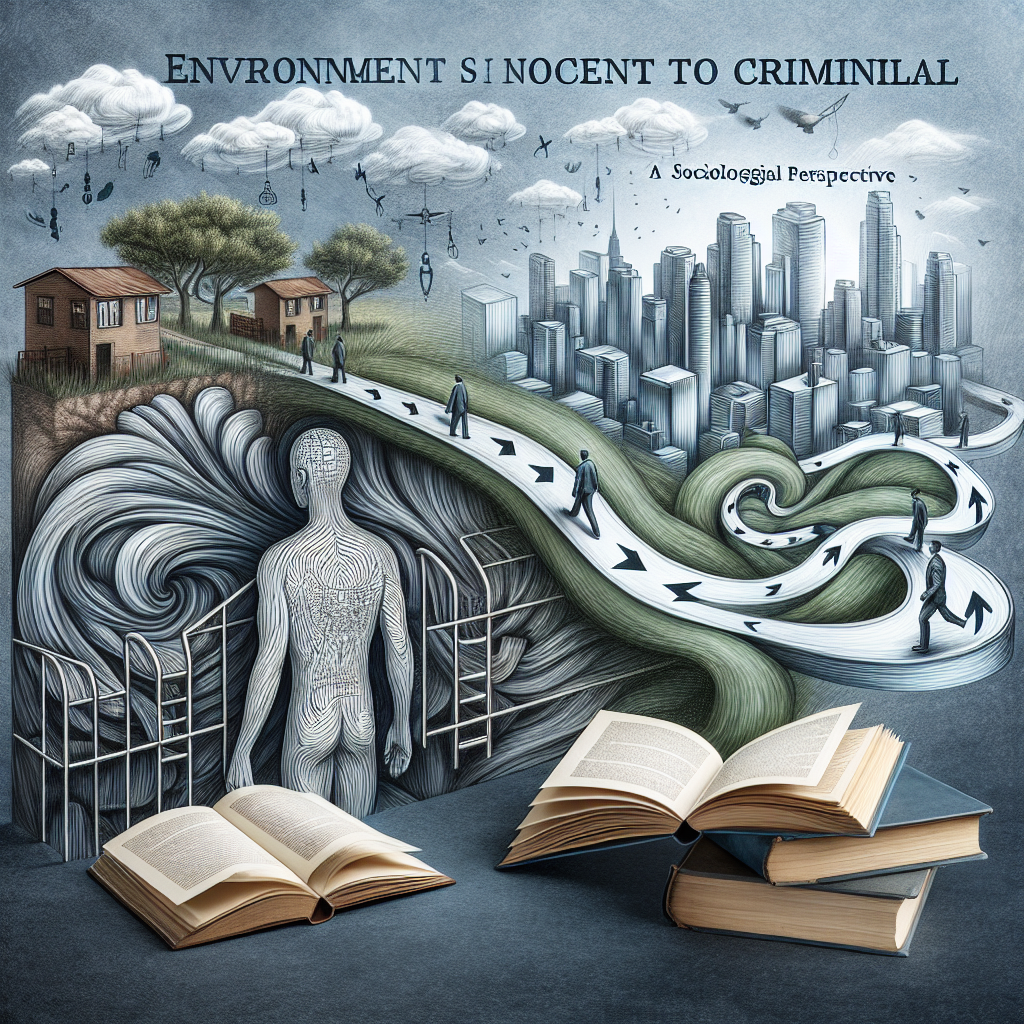
Introduction
In the broad spectrum of criminal behavior, one often-discussed yet frequently misunderstood element is the environment in which individuals live and grow. The Role of Environment in Shaping Criminal Behavior: A Sociological Perspective reveals how various environmental factors—including socioeconomic status, community cohesion, and cultural norms—play pivotal roles in determining whether an individual may engage in criminal activity. This article delves deep into those factors, providing compelling insights and real-world case studies to understand the complex interplay between environment and crime.
Understanding the Sociological Lens
The Sociological Perspective on Crime
The Sociological Perspective offers a unique view that diverges from individualistic notions of crime. While psychological theories may focus on the individual’s mind, sociology looks at the larger societal influences. Criminologists using a sociological lens study patterns of behavior in social contexts, thus laying the groundwork for understanding The Role of Environment in Shaping Criminal Behavior: A Sociological Perspective.
Table 1: Major Sociological Theories of Crime
| Theory | Key Concepts | Focus |
|---|---|---|
| Social Learning Theory | Imitation, reinforcement | Peer influence |
| Strain Theory | Societal goals, means to achieve them | Discrepancy between goals and means |
| Social Control Theory | Bonds to society | Weak social ties lead to crime |
| Labeling Theory | Social labels, self-identity | Impact of societal labels on behavior |
Why Environment Matters
The environment is more than just a physical space; it’s an amalgamation of social, economic, cultural, and familial factors. Researchers argue that these elements combined can create conditions ripe for criminal behavior. For instance, high-poverty areas may have limited access to quality education and job opportunities, leading residents to seek income through illicit means. This perspective underscores The Role of Environment in Shaping Criminal Behavior: A Sociological Perspective.
Environmental Factors Influencing Criminal Behavior
Socioeconomic Status
One of the most significant environmental factors is an individual’s socioeconomic status (SES). According to multiple studies, low SES is closely associated with higher crime rates. Poverty can limit access to education, healthcare, and job opportunities, creating a cycle of disadvantage that can lead to criminal behavior.
Case Study: The Chicago School of Sociology
During the 1920s, researchers from the Chicago School studied urban crime rates and identified the "social disorganization" theory, which suggests that high-crime neighborhoods often lack social cohesion. In contrast, communities with strong social networks tend to have lower crime rates. This research illustrates the connection between environment and crime, reinforcing The Role of Environment in Shaping Criminal Behavior: A Sociological Perspective.
Community Cohesion
Another crucial environmental element is community cohesion. Strong, supportive communities can act as protective factors against crime. Social bonds among residents promote mutual accountability and discourage illicit activities.
Table 2: Elements of Community Cohesion
| Element | Description |
|---|---|
| Trust | Residents trust each other, leading to collective action |
| Social Networks | Strong connections foster support and deter criminality |
| Shared Values | Common beliefs help unify the community |
Cultural Norms and Values
Cultural attitudes towards crime are another important environmental factor. Societal norms can either discourage or condone criminal behavior. For example, in cultures where dishonesty is tolerated or even celebrated, individuals may be more likely to engage in criminal activities.
Case Study: Cultural Norms in Gang Activity
Gang cultures often harbor unique codes of honor that can prioritize loyalty over legal behavior. For instance, in certain urban neighborhoods, gang affiliation may provide identity and support but simultaneously promote violence and illegal activities. Understanding this cultural backdrop is essential to grasp The Role of Environment in Shaping Criminal Behavior: A Sociological Perspective.
The Role of Education
Educational Access and Criminal Behavior
Education serves as a critical buffer against crime. Communities with strong educational infrastructures provide youth with the tools to succeed and reduce the likelihood of engagement in criminal activities.
Case Study: The "YouthBuild" Program
"YouthBuild" is a program aimed at providing education and job training to underserved youth. Participants often demonstrate significant decreases in criminal behavior post-participation. This program showcases how fostering educational opportunities can transform lives and address The Role of Environment in Shaping Criminal Behavior: A Sociological Perspective.
School-Related Factors
School environments also play a massive role in shaping behavior. Schools that emphasize discipline, support, and respect often produce students less likely to engage in delinquency. Conversely, negative school climates can exacerbate behavioral issues.
Table 3: Positive School Environment Factors
| Factor | Impact on Students |
|---|---|
| Teacher Support | Increased engagement, lower dropout rates |
| Resource Availability | Access to extracurricular activities and counseling |
| Peer Influence | Positive peer culture encourages prosocial behavior |
The Impact of Media
Media Influence on Perception and Behavior
Media portrayal of crime can further complicate the societal understanding of criminal behavior. Sensationalized reporting can skew public perceptions, leading to fear and distrust in communities. This can, paradoxically, perpetuate cycles of crime.
Case Study: The "Super Predator" Myth
During the 1990s, media-focused anxieties about "super predators," a term that referred to a supposed wave of juvenile delinquents. This narrative unjustly painted many youth—and particularly those from marginalized communities—as inherently violent, failing to consider the environmental context that fosters such behavior. This example highlights The Role of Environment in Shaping Criminal Behavior: A Sociological Perspective.
Social Media and Crime
Social media can also play a dual role, acting as both a platform for social support and a catalyst for criminal behavior. The rise of cyberbullying and online harassment illustrates how digital environments can shape negative behaviors.
Interventions and Community Programs
Community Policing
Community policing initiatives emphasize collaboration between law enforcement and communities to create safer environments. This strategy recognizes the vital role of community buy-in and trust in reducing crime rates.
Case Study: The "Operation Peacemaker Fellowship" in Richmond, California
This innovative program addresses gun violence through mediation and community engagement, achieving significant reductions in crime over the years. It serves as a prime example of how community-oriented approaches can effectively tackle The Role of Environment in Shaping Criminal Behavior: A Sociological Perspective.
Economic Development Initiatives
Economic development programs aimed at revitalizing impoverished neighborhoods can have a profound impact on crime rates. By improving employment opportunities and living conditions, these initiatives can alter the environment in which individuals find themselves.
Conclusion
In wrapping up this exploration of The Role of Environment in Shaping Criminal Behavior: A Sociological Perspective, it’s clear that the interplay between individual and environment is complex yet crucial for understanding criminal behavior. From socioeconomic factors to community cohesion, the influences are multifaceted, calling for holistic interventions.
While no single factor can account for criminal behavior, recognizing the substantial role of environment provides an avenue for community engagement, effective policy-making, and ultimately, crime reduction. Everyone has a role to play in shaping more positive environments that deter criminal behavior and promote social well-being.
FAQs
1. How does socioeconomic status influence criminal behavior?
Socioeconomic status often limits access to education and job opportunities, which can push some individuals towards criminal activities as alternatives for earning income.
2. What role does community cohesion play in crime prevention?
Strong community bonds foster mutual accountability among residents, thereby discouraging illicit behavior and creating a safer environment.
3. Can education really reduce crime?
Yes, educational programs provide the skills and opportunities necessary for personal development and economic success, thereby reducing the likelihood of engagement in crime.
4. How does media reporting affect public perception of crime?
Sensationalized media can cause increased fear and stigma, often portraying certain groups as inherently violent without considering the environmental factors at play.
5. What can communities do to reduce crime rates?
Communities can focus on fostering educational opportunities, economic development, and improving social cohesion to create a safer and more supportive environment.
This comprehensive exploration of The Role of Environment in Shaping Criminal Behavior: A Sociological Perspective offers valuable insights into how various factors interplay to influence criminality. By addressing these core issues, we can promote a more informed dialogue around crime and its prevention.















